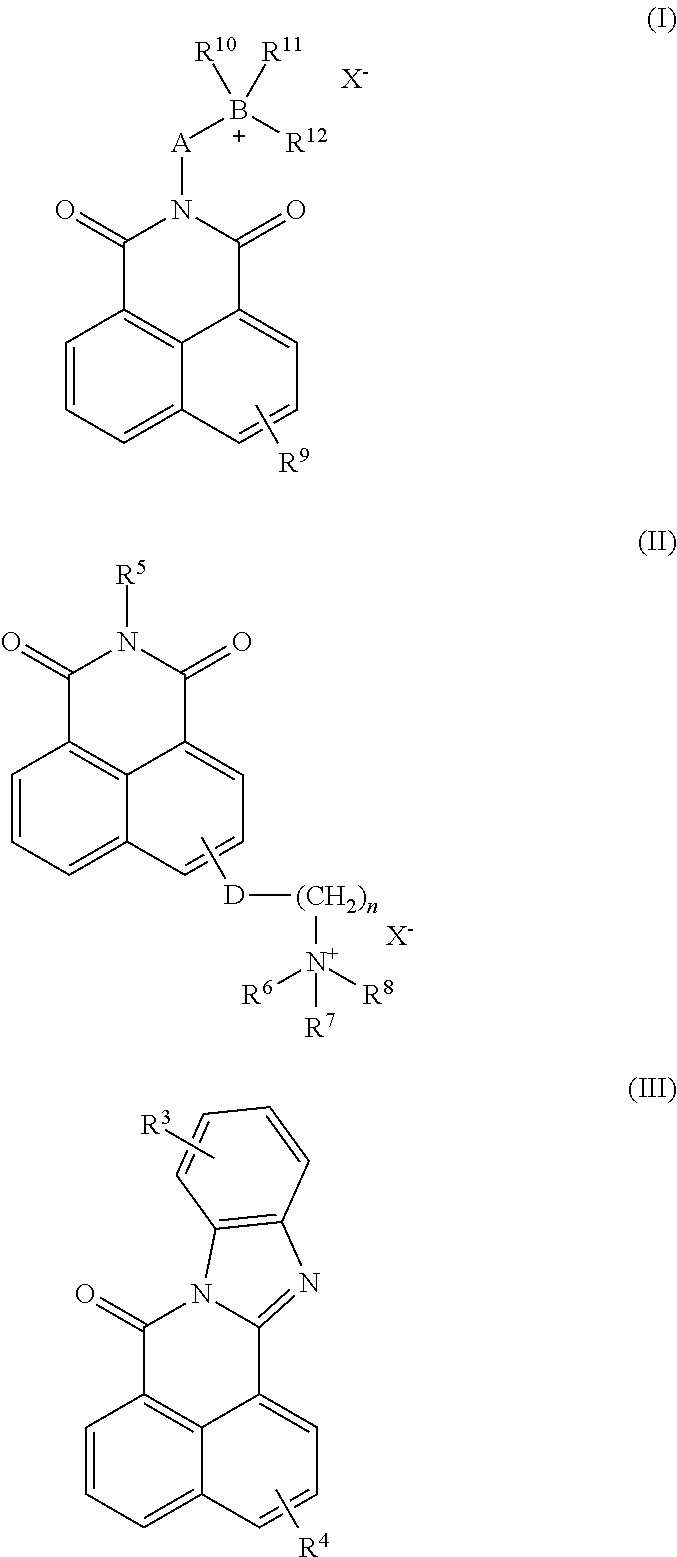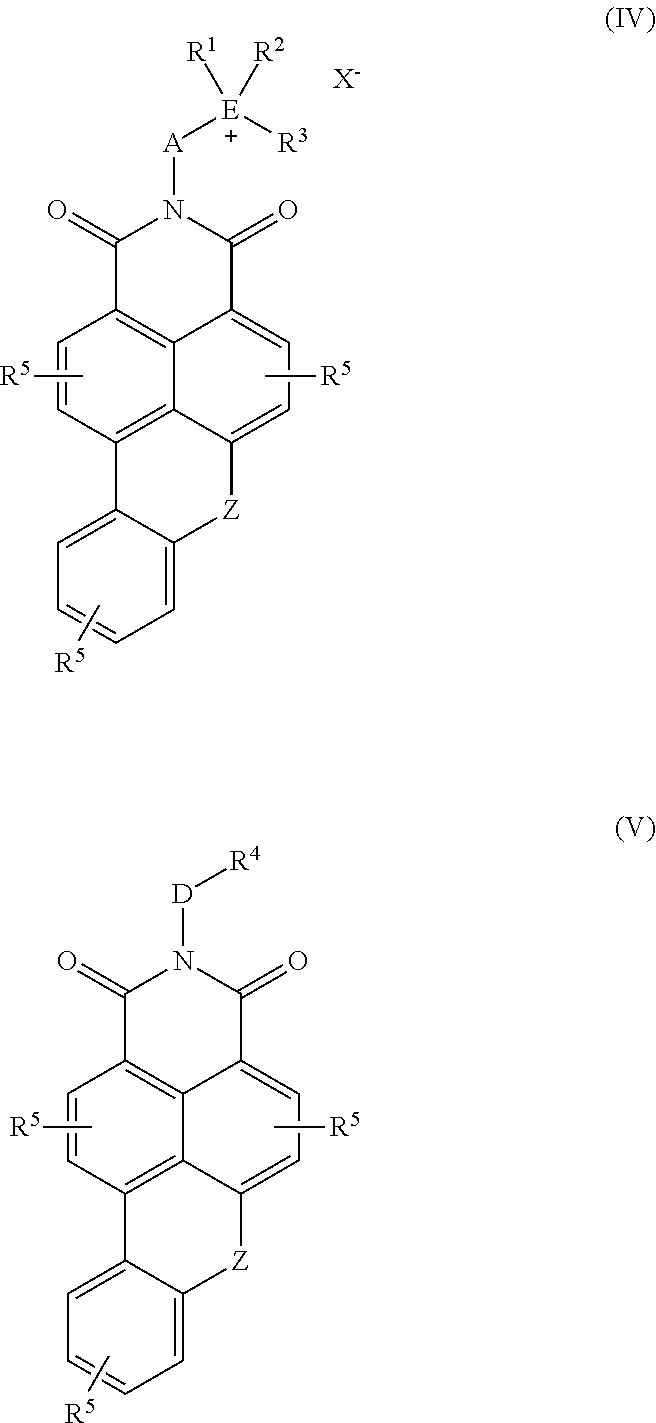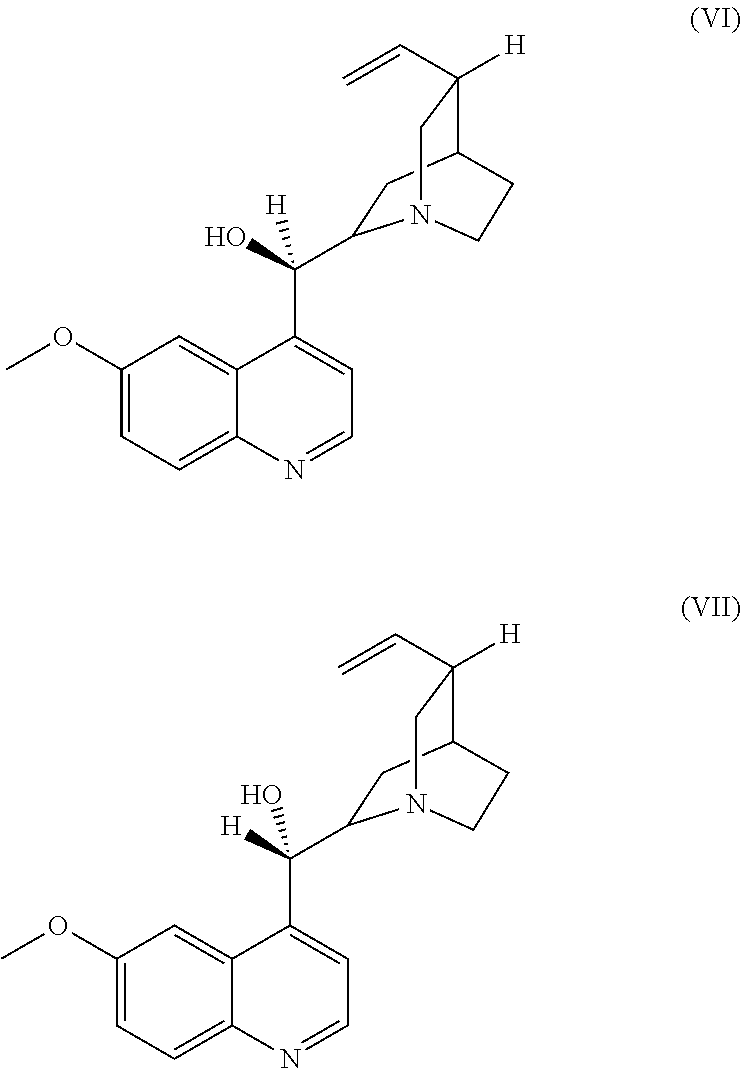Use of fluorescent polymers in marking compositions for the diagnostic determination of cleaning performance
a technology of fluorescent polymers and compositions, applied in the direction of fluorescence/phosphorescence, rigid containers, disinfection, etc., can solve the problems of compromising the use of fluorescent marking systems to audit cleaning efficiency, unable to control with present antibiotics, and no patient is immune from the risk of infection
- Summary
- Abstract
- Description
- Claims
- Application Information
AI Technical Summary
Benefits of technology
Problems solved by technology
Method used
Image
Examples
example 1
Synthesis of fluorescent monomer 4-methoxy-N-(3-N′,N′-dimethylaminopropyl)naphthalimide 2-hydroxy-3-allyloxypropyl quaternary salt (“BRT1”)
[0165]
Step One: Synthesis of 4-chloro-N-(3-N′,N′-dimethylaminopropyl)-naphthalimide (I)
[0166]A 500 mL 3-necked round bottom flask equipped with a mechanical stirrer (½ moon Teflon blade) and water condenser was charged with 4-chloro-1,8-naphthalic anhydride (23.3 g, 0.1 mol), 3-dimethylaminopropylamine (10.37 g, 0.102 mol), and glacial acetic acid (21 mL). The mixture was heated to reflux with stirring for three hours. Upon cooling, deionized water (200 mL) was added, followed by 50% sodium hydroxide solution (32 g, 0.3875 mol). The resulting tan precipitate was collected by filtration, washed with deionized water, and dried under vacuum.
Step Two: Synthesis of 4-methoxy-N-(3-N′,N′-dimethylaminopropyl)-naphthalimide (II)
[0167]A 250 mL 3-necked round bottom flask equipped with a mechanical stirrer (½ moon Teflon blade) and water condenser was charg...
example 2
Synthesis of fluorescent monomer 5-allyloxy-4′-carboxy-1,8-naphthoylene-1′,2′-benzimidazole
[0169]
Step One: Synthesis of 5-chloro-4′-carboxy-1,8-naphthoylene-1′,2′-benzimidazole (I)
[0170]A 100 mL round bottom flask was charged with 4-chloro-1,8-naphthalic anhydride (4.65 g, 19.99 mmol), 3,4-diaminobenzoic acid (3.08 g, 20.24 mmol), and glacial acetic acid (50 mL). The mixture was heated at reflux under nitrogen for five hours and then cooled. The solid was collected, washed with isopropanol, and dried under vacuum.
Step Two: Synthesis of 5-allyloxy-4′-carboxy-1,8-naphthoylene-1′,2′-benzimidazole
[0171]A 300 mL Parr reactor was charged with 5-chloro-4′-carboxy-1,8-naphthoylene-1′,2′-benzimidazole (I) (0.7 g, 2.01 mmol), allyl alcohol (20 mL, 0.294 mol), and potassium hydroxide (0.23 g, 4.1 mmol). The reactor was purged for 10 minutes, sealed, and then heated at 150° C. for four hours. Upon cooling, the volatiles were stripped and a crude orange solid was obtained.
example 3
Synthesis of fluorescent monomer 6-vinylbenzyloxy-4′-carboxy-1,8-naphthoylene-1′2′-benzimidazole
[0172]
Step One: Synthesis of 6-hydroxy-4′-carboxy-1,8-naphthoylene-1′,2′-benzimidazole (I)
[0173]A 100 mL round bottom flask was charged with 3-hydroxy-1,8-naphthalic anhydride (4.29 g, 20.04 mmol), 3,4-diaminobenzoic acid (3.04 g, 19.97 mmol), and glacial acetic acid (50 mL). The mixture was heated at reflux under nitrogen for five hours and then cooled. The solid was collected, washed with isopropanol, and dried under vacuum.
Step Two: Synthesis of 6-vinylbenzyloxy-4′-carboxy-1,8-naphthoylene-1′2′-benzimidazole
[0174]A 100 mL round bottom flask was charged with 6-hydroxy-4′-carboxy-1,8-naphthoylene-1′,2′-benzimidazole (I) (1.66 g, 4.5 mmol), vinyl benzyl chloride (0.92 g, 6.05 mmol), and potassium carbonate (2.38 g, 10 mmol). The mixture was heated at reflux in acetone for eight hours and then cooled. The mixture was then poured into water, acidified, and the orange solid was collected.
PUM
| Property | Measurement | Unit |
|---|---|---|
| weight average molecular weight | aaaaa | aaaaa |
| wt. % | aaaaa | aaaaa |
| wt. % | aaaaa | aaaaa |
Abstract
Description
Claims
Application Information
 Login to View More
Login to View More - R&D
- Intellectual Property
- Life Sciences
- Materials
- Tech Scout
- Unparalleled Data Quality
- Higher Quality Content
- 60% Fewer Hallucinations
Browse by: Latest US Patents, China's latest patents, Technical Efficacy Thesaurus, Application Domain, Technology Topic, Popular Technical Reports.
© 2025 PatSnap. All rights reserved.Legal|Privacy policy|Modern Slavery Act Transparency Statement|Sitemap|About US| Contact US: help@patsnap.com



